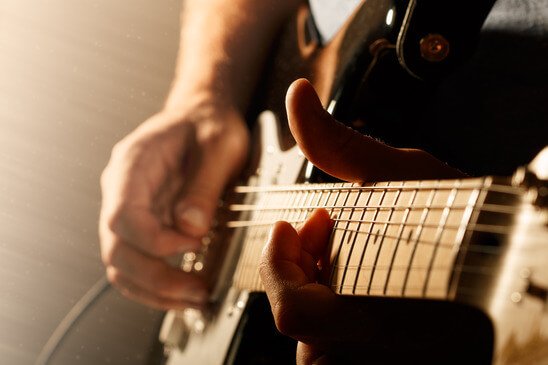Whether you play acoustic, electric, or both, one trick that really seems to win a listener over is a good bend or two.
Just remember that like any other flashy or fancy trick, using bends in moderation is key. Too many bends can be annoying and obnoxious to listen to. But, if used sparingly, bends can add a lot of excitement and character to any lead or rhythm part.
One of the things I've noticed over the years is that a lot of beginning guitarists aren't getting the most out of their bends. To show you what I mean, over the next few posts I'll give you three quick and easy tips on proper guitar bending technique.
I'll also quickly throw in a little side note here and say that bends on electric guitar are much easier than they are on acoustic. This is because of the thickness and the type of strings used on acoustic guitars. That's not to say they can't be done on acoustic, they're just harder.
Your Thumb Is Your Friend
Probably the biggest tip I can give you right off the bat is this:
If you're not using your thumb, you're missing out on a huge amount of strength behind each and every bend.

- Simply wrap your thumb around the top of the neck as you're bending.
- Then, whenever you bend, use your thumb like an anchor point and squeeze your fingers and thumb together.
Simple enough, but you'll generate so much more power behind your bends this way.
If you're new to this whole, thumb-over-the-neck thing, getting your thumb up and around the back of the neck may seem a little awkward at first. This is especially true in context of trying to work it into whatever song you're playing. But don't worry, just like all new things, it will just take a bit of practice to get used to.
Can't We All Just Get Along?
One last thing I feel like I should mention is that I've had some guitar teachers in the past, and even some other guitarists say that you should never wrap your thumb around the neck. That it's not "proper traditional playing technique".
Well, the only thing I can really say to that is, if you want to stay traditional then go for it. It's not bad or wrong to play in a traditional or classical style. Just know that by doing so, you're missing out on a major source of help by not letting your thumb take some of the work load off of your other fingers.
Naturally, when the work load is more evenly distributed, your fingers will last a whole lot longer. And that's always a good thing.
To see Part 2 of the series on guitar bends, click here.
To see Part 3, click here.